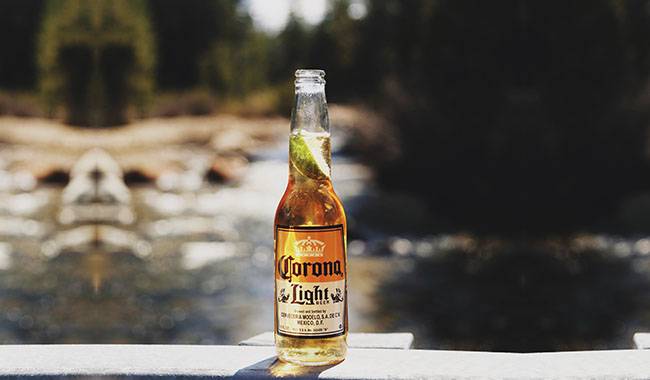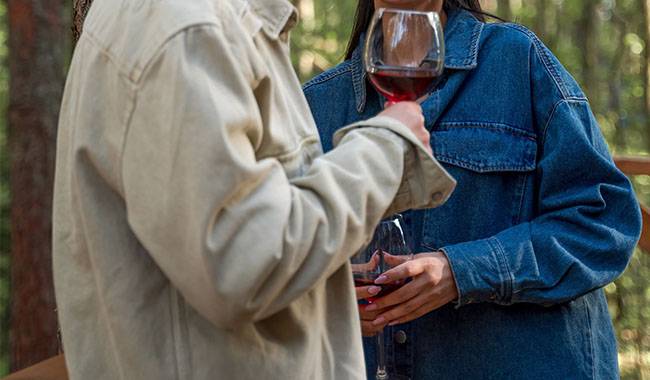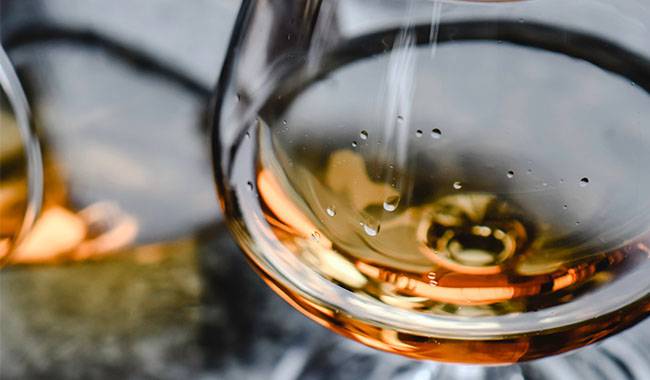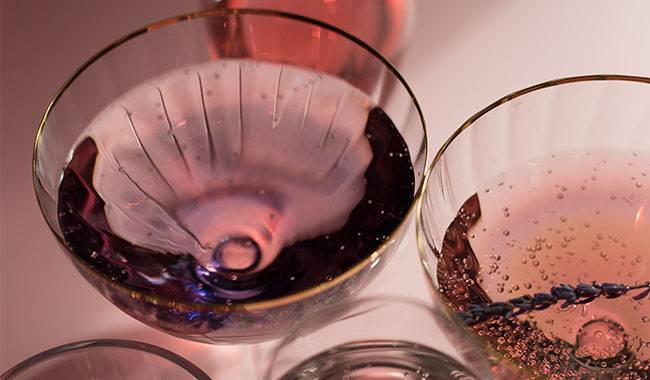
Alcohol is one of the many pleasures of vacation and travel. So let’s not presume to pretend that we are all hard-core sportsmen and abstainers. Even the climbers who descend the 4.3 miles (7 km) high mountains observe their sporting regimes before summiting, dreaming of reserving a bottle of brandy for those who complete the ascent at base camp. At the finish of well-organized marathons, pretty girls hand out cans of beer to those who finish regaining their strength. In Alpine shelters, there is always a mug of mulled wine for those who have encountered bad weather. Generally speaking, wine has its place in most Hiking and at the finish line. You will learn more about It’s Lovely to Have a Drink in Nature by LCNOutdoors article.
That’s why it’s not about the pros and cons, or even the quantity, but about the aesthetics of wine on a trip. If in the city we can sit in a restaurant where the waiter knows which glasses and snacks are served with which drinks, or in a bar where the range of cocktails covers an entire wall, then in a sport with even a simple “mattress” there is a very limited set-up of tableware and snacks. But this is not an occasion to drink hastily made wine from a cut-down jar with pasta and stew, no! This is a good opportunity. Visitors are not bums. And at the end of an active day, drinking beautifully in the evening is a separate art. Now more than ever, there are lots of cool installations to do this.
Mulled Wine Aesthetics in Hiking & Camping

Mulled wine is the most popular drink on a cold day and has been known since college days. Warm and invigorating, cheerful and creative – it was drunk by the Knights of the Round Table during the Crusades, so how could we do any worse?
How to cook mulled wine
There are quite a few variations, and mulled wine can be made with any natural wine or even without wine. Red or orange wine is best, but white wine can also be used. Excellent mulled wine is made with berry wine – raspberry or blackcurrant mulled wine will cure a mild cold in no time.
Making mulled wine at a boil is not recommended – the spices do not have time to release their flavors. It’s best to take a more traditional frying pan for a campfire and a barrel frying pan with a long handle that allows you to quickly catch the right moment to remove it.
- Basic ingredients: wine, sugar, or honey; spices: pepper, cinnamon, cloves, any fruit.
- Variations of ingredients: ginger, cardamom, batanas, water, brandy.
Fruits – apples, pears, lemons, oranges, apricots, whatever you brought or picked on the way, cut them up and put a layer in the bottom of the pan, about a quarter of the way up. You can also put some big spices (it’s usually handy to keep them in small containers): cinnamon sticks, cardamom and peppercorns, bay leaves, cloves, and accordion stars (don’t go too heavy: 5 cloves per 0.26 gallon and one accordion star is enough), ginger slices, juniper berries …… All of these things are loaded to the top of the wine. You can add a quarter of a pot of water. You probably won’t, depending on the number and age of the drinkers. For students with no drinking experience, it’s best to dilute it. And strong men, tired from a long day of winter battles, will do well with even a glass of brandy added to hot wine.
Put it on the fire or burner, watch the process carefully, and once bubbles begin to actively form on the walls – remove it. The wine should be heated to 194 °F (90°C) – (at higher altitudes, adjust for the lower boiling point), but it should not boil! If you decide to make a stronger mulled wine, 50 grams of cognac per 0.26 gal (1 liter) of mulled wine must be added at the time of skimming, not before.
If you think of bringing a thermos of mulled wine on a field trip, you put all the spices and fruits directly into the thermos and the sugar into the thermos. The wine is heated over the fire and poured on top. It’s all nicely infused when you bring it with you!
How to drink mulled wine
Always drink from a mug! Even better, it’s a thermos, so it won’t get cold over time and allow you to stretch your enjoyment. If you’re not too lazy to bring fruit and wine and don’t be lazy to bring a camping spoon, it’s easy to dispense delicious fruit from the bottom of the cauldron, and overall, there are nice moments in it – the expectantly stretched mug, the slyly smiling waiter, the orange slices on the red background, the orange reflections on the rocks and pine trees ……
The perfect appetizer for mulled wine
Mulled wine doesn’t actually need an appetizer – it already has fruit in it. It can be served before or after dinner. But not together! Drinking mulled porridge is an unethical act. If you want a snack, you can buy some fresh rolls from the village, toast some bread and cheese by the fire, or simply put some unsweetened crackers in a bowl.
Tip: If there are children and non-drinkers in the group, you can make a separate pot of non-alcoholic mulled wine with berry juice instead of wine, all other ingredients are the same. The fun will be shared!
Wine Aesthetics in Camping
On a summer trip to the wine regions – the Alps, Pyrenees, Tatras, Georgia, Moldova, and Crimea – it is a sin not to taste the local wines. Good wine is fun, inspiring and opens our chakras of kindness, friendship, and love. All in all, it’s a great part of a vacation.
If you’re driving in, or if your campsite is close to a store, you can also leave your wine in the bottle, but be sure to pick it up afterward and throw it in the trash.
How to transport wine
If you are floating on a river, traveling by car or bicycle and you don’t particularly care about weight, you can open a glass bottle at night. If you’re on a biking or light rafting trip, a hiking trip, or a camping trip, you’ll have no problem having a glass of wine at night. And you can even carry 0.26-0.52 gal (1-2 liters) of wine on Hiking. You just need to transfer it from a glass bottle to a plastic bottle before transporting it, or better yet, to a special decanter that will preserve its flavor. This is especially true if you buy or take young wines as a treat, as young wines tend to ferment when exposed to air and shaking. The bottle compresses easily, reducing the presence of air in the wine to zero, and the wine does not become acidic and stays delicious and fresh for a long time. For aesthetes, there are beautiful portable flasks that include glasses.
How do you pour the wine? You can, of course, pour it into a mug. But for a wine that is not strong, but rich in flavor, an entourage is very much needed. At one time, aristocrats used to drink from silver and bronze goblets and bowls while hunting, admiring the reflection of the setting sun on the walls of the goblets and drinking sparkling wine. In the early twentieth century, food-coated brass goblets were quite popular and not uncommon in grandmother’s closets and antique dealers. Twenty-first-century outdoorsmen have made wine glasses out of lightweight steel. And for those who could easily walk around – there were even folding wine glasses! It’s impossible to break them. They don’t take up much space in a backpack. And a sip of wine from a glass in a beautiful landscape will taste ten times better!
A sip of wine from a glass in a beautiful landscape will taste ten times better!
If the trip involves a fixed base – a hiking camp, an alpine ski camp, water training, etc. – even a Hiker can bring a camping chair. And at night, with a glass of wine in hand, admire the mountains shining under the moon or listen to the water splashing and the birds singing. At such moments in life, the best ideas are born, poems and songs are written, people become friends, hearts are opened, and peace and harmony follow.
The best appetizer for wine
Local cheese or charcoal-grilled meats. Pies, buns, honey pancakes, khachapuri, unsalted dry cheeses (Kurut, Kurt), smoked sausages, dried meat slices, pasta with fruits and vegetables, fried fish (under white only), various raclette, etc. Wine accompaniments are varied and can be enjoyed with dinner, or even afterward, in the midst of unhurried conversation. Perhaps only hot soup is absolutely inappropriate.
Tip: Wine without cheese is money down the drain! Don’t forget to bring a container to carry your cheese safely.
The Aesthetics of a Beer Glass

When you are traveling in the Czech Republic or Bavaria, sampling the local beer is a must. Yes, you can’t take too much with you when climbing a mountain. Although in travel clubs in Europe and America, it is even acceptable for people to bring a can of beer up the mountain. Everyone in the group will have a sip, but it will be a hundred times sweeter than on the plains!
In most cases, however, the beer is bought at the end of the day before the break. But you still have to walk or drive to camp! This is impossible. There is a risk that a binge sip of cold beer during this time will turn into a sip of warm white wine. If this is the case, a thermos can help, or if you don’t have one, use a regular thermos. It will keep your beer cold for a few hours, allowing you to find a place to sleep and set up camp.
How to pour beer
The best way to drink beer is to use a large, tall glass and put the foam cap in it. Slide the glass more pleasantly across the table. And drink leisurely, sitting in an armchair, hanging a bottle of beer or wine exclusively!
Best beer snacks: smoked sausages and crunchy crackers with coarse salt.
Spiritual Aesthetics
Cognac brandy, Grappa and Chacha on a hike
These beverages are the product of distilling and aging grape and fruit spirits and are a separate group because the aesthetics of drinking them are different from both drinking wine and taking alcoholic beverages. If you travel to Georgia, Armenia, France or Italy, grape spirits in varying degrees are an important part of the culinary culture there.
Grappa is made from barren ingredients, i.e., the pomace from the grape winemaking process is a symbol of Italian style, perhaps even more so than wine.
Chacha is a Georgian pomace brandy, clear and strong, sometimes called “wine vodka”, “grape vodka” or “Georgian vodka/grappa “. It is made from grape pomace. Georgia uses the word “chacha” to refer to the grape distillate. It can also be produced from unripe or wild grapes.
How to carry Cognac with you
If weight is not an issue, like wine, but unlike wine, cognac, chacha, and grappa are not afraid of air, you can enjoy a few sips of cognac and then leave them an unused bottle in your backpack and you will have that opportunity again the next night.
However, they have a special container – the famous Cognac bottle. You can take such a bottle with you for a simple but spectacular radial race, take a sip of brandy to celebrate the successful completion of the free ride route, and warm up before going to bed in the winter Hiking.
How to pour cognac and other wines
Foraged, fragrant cognacs and grappa, a glass with a slightly inflated bottom are very good. For chacha – a small glass of 25-50 grams. Both have Hiking options, they are not heavy, you can put them in your pocket, pour them over the whole company, and toast – much more enjoyable when everyone is in a circle and everyone is pouring.
What food to serve with Cognac
The best quick meal with cognac or grappa in a flask is chocolate, dried fruit, and nuts. Any visitor keeps all this in his pocket and complements the cognac.
For more comfortable conditions, an appetizer of Cognac brandy – the “Classic Appetizer” is appropriate. It was invented by Emperor Alexander III, who was a great admirer of cognac, and it is done like this: two pinches of sugar are poured around a lemon slice. In the middle – a small pinch of coffee powder. In the mouth, such an appetizer should be placed completely in mouth.
Take a sip of chai tea, Grappa – wait a minute, do not rush to eat. Feel the taste of grape seeds, how it flows warmly down your throat, how the stars become brighter as if a cloth has been wiped across the sky. And only then eat a piece of tart, salty cheese, or basturma.
All of these drinks are strong, so you can and should eat them with any hot meal, pour them over your dinner! The blissful warmth will spread throughout your body, your blood vessels will quickly dissipate the lactic acid that has built up in your muscles during the day, and the conversation and laughter won’t stop for long around the fire or the camping table.
Tip: If Hiking is done in inclement weather conditions and you need to warm up in the evening, never drink hard liquor while standing in the cold! It is important to understand that the warming effect of alcohol from the inside out is very short-lived, 10-15 minutes, and not much longer. After that, you will get colder. It is good to warm up with a sip of spirits when it is cold during the day, but you are already sitting in the tent, dry clothes and warm sleeping bags are ready, hot food sizzling on the stove in the vestibule. You can pump up in small doses during the physical work, and if you need to do it urgently, you will have rest, food, and warmth. But in case you get lost, encounter bad weather, and get frozen by the wind, don’t rely on toughness and wait for help from your comrades or heavenly rewards. Here, not even twenty years of cognac can help you.
Vodka and Alcohol-based Tinctures for Camping

Vodka and vodka-based tinctures are popular drinks when camping in the United States. It’s cheap, effective, relaxes muscles, warms the throat nicely, gets rid of colds, and is overall a hard-working drink. The only drawback is that it has an alcoholic taste. That’s why a glass of vodka, unlike brandy and chacha, is consumed in one gulp after exhaling and having to snack on it!
Alcohol-based liqueurs are very popular in Europe: the famous German Jägermeister and its variants, the mild French Génépi, the Italian Limoncello, and Sambuca, etc. Sake is available in Japan and Korea. They each have their own drinking traditions and drinking them as vodka is disrespectful, to say the least. So, before you buy one, ask the locals exactly how you should serve the liqueur to bring out all the flavors and follow the instructions – you won’t regret it. For example, sambuca heated with coffee beans is very good. génépi is served in a miniature glass so that the rosemary flavor brings back the dreams of Provence.
How to Make Vodka From Spirits
If you do not bring ready-made vodka or tinctures, but pure alcohol, make sure you send someone to take care of diluting it. This business is subtle and important, and the wrong diluted alcohol will have neither warmth, relaxation, nor anti-stress effects. If there is no benefit, why carry it on your shoulders?
First, you should dilute the alcohol for at least an hour or two before drinking it. Better yet, it should be drunk in the morning or the night before. The mixture of alcohol and water creates a chemical reaction that releases heat. The full reaction actually lasts for seven days, and putting an end to it during a workout doesn’t make any sense – but most positive alcohol reacts with water in the first place, and then the drink is already ready to use without any harm to your health. In addition, the habit of diluting alcohol in the morning precludes the requirement for refills. You can drink as many precious grams as the steward gives you in the morning. If you do not take ready-made drinks and are bothered by alcohol – it means that the movement is distant, all by yourselves, and there is no civilization on the route.
Therefore, let’s prepare containers. It is not advisable to use mineral water to make alcohol in plastic bottles. It is better to take a high-quality plastic water bottle with measuring graduations that will not affect the purity of the product. If you do not have a measuring cup, take a measuring cup (there are special travel cups with volume markings) and pour 3** ml of water.
Add 2** ml of alcohol to it (by pouring the alcohol into the water, not the other way around!). Of course, it’s more accurate to mix the same proportions by weight, but that’s not realistic in camping, so mix by volume and there will be an error, but not a big one. The more accurate you are, the more delicious your dinner will be!
If you have 10 minutes and extra bandages in your medicine cabinet – you can add some charcoal and strain the vodka through two layers of gauze in the evening before it cools. Activated charcoal from the drugstore won’t work, it will make the drink cloudy! Just some juniper or birch charcoal from a campfire is even better – it’s an excellent absorbent. Flavor additives made from local products are great: sure, you won’t make a full-fledged tincture in a day, but the aroma of anise seeds, thyme, wild currants, or honey, a hint of citric acid, sugar, or glucose will make the diluted alcohol softer and more enjoyable. If the day is very hot and the honored wake’s backpack is warmed by the sun, you can and should put the jar in cold water for 15 minutes before drinking. Because warm vodka is not at all aesthetically pleasing!
How to pour: Pour into a soup stopper. The dose is more accurate, more comfortable to drink, and more economical: a night’s dose is enough for three glasses instead of two.
What Snacks Go With Vodka
The best snacks are hot, hearty foods. The vodka itself has no flavor, but it enhances the flavor of food. Even plain buckwheat and jerky taste twice as good. And if you’re eating ears, porcini mushroom stew, or other camping fares for dinner, it will taste three times better.
Tip: For the girls, there’s an old-fashioned Hiking recipe. 50 grams of vodka – a teaspoon (okay, okay, okay, a tablespoon) of condensed milk and 50 grams of strong coffee. Mix it all up, cool, and enjoy.
The Aesthetics of Wine and Its Variations in Hiking
This is a popular low-alcohol drink to warm up a cold night. It has no dehydrating effect after a day of Hiking, and the ingredients are easier to find when you go camping.
It’s best to drink it the mulled wine way – with a thermocouple. This way, the wine retains its temperature and aroma longer.
The classic grog is a strong black tea, rum, spices, and lemon. We start by pouring the lemon slices into the tea and then squeeze it with a spoon to get the juice out, before adding the rum and a little cinnamon and cloves. The amount of rum is a matter of taste; the classical approach is 30-50 ml per two hundred and twenty ml cup of tea.
Tip: Grog is any of a variety of alcoholic beverages. The term originally referred to rum diluted with water, which was introduced on August 21, 1740, by British Vice Admiral Edward Vernon into the naval squadron he commanded in the West Indies. Vernon wore a grog jacket and was nicknamed Old Grogam or Old Grog.
The Admiral’s tea was for connoisseurs. An absolutely extreme recipe is given in one of Mikhail Weller’s stories: “Two admirals sat at the table with two cups of lemon tea and a bottle of brandy. Take a sip of the tea and add the brandy. Take another sip and add the brandy again. And when the bottle is empty and the cup is still full, this is the real admiral’s tea”.
But in promotional campaigns, the recipe is usually more simple: 30 grams of cognac in a cup of tea with lemon and cardamom.
We brew it with a cup of boiling water and a tablespoon of Hibiscus tea (for those who haven’t had it, the rose petals from Sudan taste rather sour), add sugar or honey, cinnamon, cloves, ginger, and 25 grams of vodka or cognac, rum or Grappa. it tastes like berry wine! This drink doesn’t need heavy ingredients, but it’s great to drink in the mountains – the altitude drains the blood, and the acidic Hibiscus tea, which is high in vitamin C, neutralizes this effect.
Tips: even if the duty officer mixes up the flask and accidentally cooks the porridge in 0.26 gal (1 liter) of alcohol, this is just one more reason to get creative!